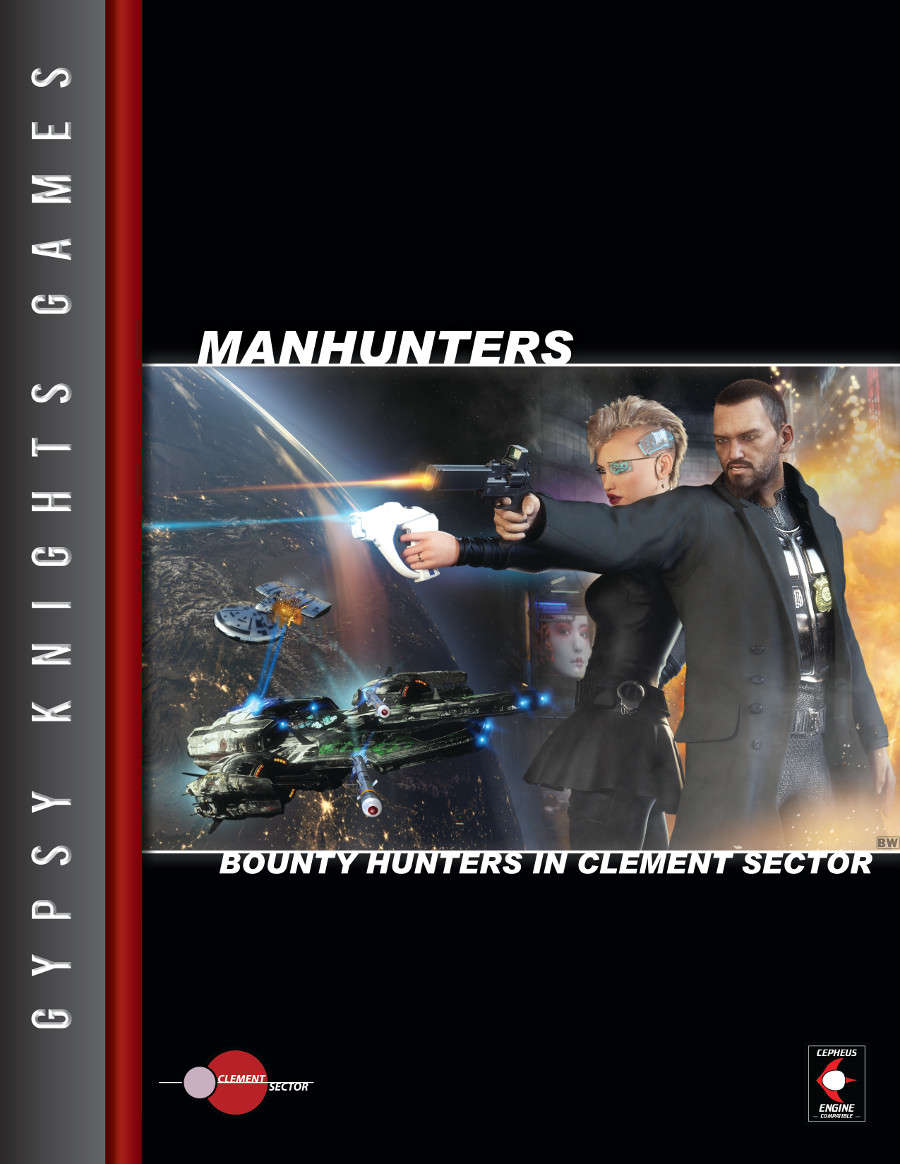Manhunters: Bounty Hunters in Clement Sector
This review was originally posted to Alegis Downport in May 2018, and appeared in the July/August 2018 issue of Freelance Traveller.
 Manhunters:
Bounty Hunters in Clement Sector. John Watts.
Manhunters:
Bounty Hunters in Clement Sector. John Watts.
Gypsy Knights Games
http://www.gypsyknightsgames.com
94pp., Softcover and PDF
US$22.99(S+P)$9.99(P only)/UK£17.26(S+P)£7.50(P only)
Manhunter: Bounty Hunters in Clement Sector is one of the new releases from Gypsy Knights Games. The material is compatible with the Clement Sector rules set or Cepheus Engine rules and could be adapted for other 2D6 SF RPG rule sets.
The bounty hunter is one of the more popular types of character that many gamers like to play; sometimes mysterious, usually tough and grizzled and always relentless; it’s easy to see why they are well liked as either player characters or NPCs. It would be remiss not to mention some of the more famous hunters from fiction such as Boba Fett from Star Wars and Deckard in Blade Runner. Io9 has an article on ten of the coolest in science-fiction.
There are also those from (real) history such as Thomas Tate Tobin who tracked his three targets and brought back their severed heads after refusing the help from a 15-strong militia. So how does GKG expand on the ‘standard’ bounty hunter character from the rules book? The author, John Watts, delves in with a couple of pages of narrative ‘Another Day on Chance’ which describes the setting up of a deal between a bounty hunter and client. After a illustration depicting the deal by Bradley Warnes, you are introduced to what makes a manhunter in the Clement Sector. The next five pages break the eight types of manhunter down to the particular specialisms they are known for.
- (Traditional) bounty hunters are usually independents who wait for a monetary bounty to be posted by, e.g., a government or corporation) for the capture or death of a criminal.
- Bail enforcement agents will track down accused persons that have jumped bail and return them to the law enforcement officials of the government that they have run away from.
- Thieftakers offer their services directly to a victim of crime, where law enforcement does not appear to obtain justice.
- Repossession agents will recover property for which payments have not been made in a timely manner.
- Altrant/Uplift hunters are repossession agents working for someone or organisation that consider altrants or uplifts as property.
- Skiptracers will search for databases and records in order to locate a fugitive or item of property.
- Debt collectors recover funds lost to a person who has promised to pay those funds but has left the area where the organisation can legally recover those funds.
- Marshals are specialised law enforcement agents tasked with the arrest and recovery of fugitives. The marshals’ remit may encompass many of the other types of ‘bounty hunting’ but only within the scope of what is legal.
Because the many worlds in the Clement Sector have different laws and views on what is or isn’t allowed, the next twenty-six pages describe in great detail the various worlds of the Hub, Cascadia, Franklin, Sequoyah and Colonies subsectors. This could get heavy going as there is a lot of text to go through (which is broken up with very fine images by Bradley Warnes) but John Watts has made the reading easy-going and engaging. Don’t expect to be able to leave one world where anything goes and stride into the bar of another world pointing your gun at your quarry and expect to get away with it. There are many nuances; it’s not just laws and governments, but many corporations have the say in a geographic area and their views take precedence. For example, the Blaylock Mining Corporation believes that if they hire anyone, their employee is free of any legal problems that they have incurred on other worlds and they will not allow anyone to bring harm to one of their employees. What is considered as slavery on world, would be perfectly acceptable for a hunter to try and bring back an altrant on the run – dead or alive.
To help expand on the background of the eight character variations, the next thirty-four pages break down the variations between the careers and describe their respective specialisms. For example, Skiptracers have variant careers such as Investigators (on the ground investigations) or Researchers (office-based research and searches). Each variant career has a skills breakdown which are slightly different, plus the usual ranks and benefits, mishaps and events tables.
The next eleven pages help the referee to work out the various types of bounties, bail, debt, thieftaking and property recovery costs. It provides a good structured way of calculating how much a hunter could receive for a job, influenced by various factors. At least this way, you have a consistent approach for costing out jobs. I’m glad to see that the book has taken a look at this as it helps to build the ‘background’ to the careers and the legal basis (if any) for the types of job taken.
To help round off the book, you get four NPC manhunters of the Clement Sector (Seth Grinder looks like someone you definitely wouldn’t mess with!) and some background on a couple organisations.
I’ve been looking forward to reading this book for some time and I haven’t been disappointed. Though the book is priced in a slightly higher-price bracket than some other GKG supplements, you get a lot of source material in just under a hundred pages. This is a cracking read and I like that the book doesn’t just cover generating careers, but also the mechanics of bounty hunting and the logistics (who will allow what and where) within the Clement Sector. Another very fine product from the GKG stable and most definitely worth picking up! I would like to thank very much John Watts for sending me a copy of ‘Manhunter’ to review.
 Freelance
Traveller
Freelance
Traveller